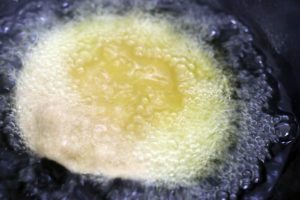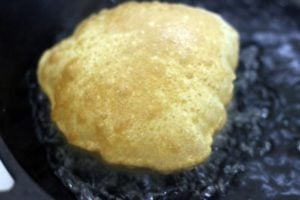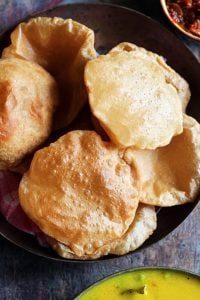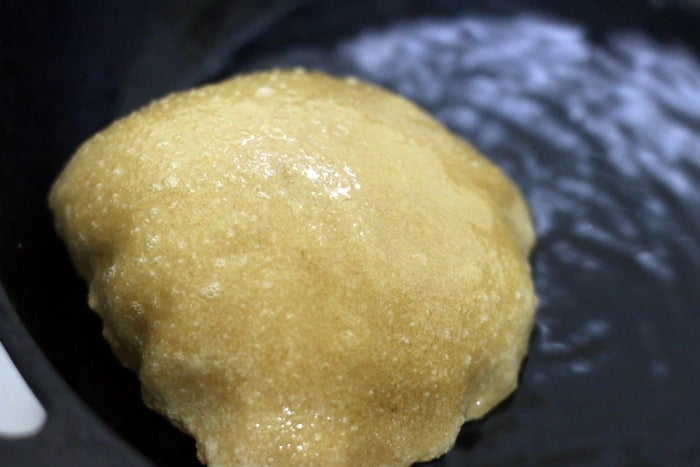Poori is a crispy, golden, unleavened fried Indian bread made with whole wheat flour. It is one of the most popular Indian breakfast served with a spicy potato curry, fondly called as poori masala or puri bhaji. It is also eaten with chana masala or sweet dips like aamras.
Here is a detailed step by step recipe with all tips, tricks and trouble shooting to make crispy poori recipe at home.
For more Indian breads please check aloo paratha, plain paratha, kulcha, butter naan recipes.
A good breakfast is a must for the good start of the day, do you agree? In India there is no dearth of variety of breakfasts. Hot, fresh, homemade or from small joints, sweet or spicy there is something for everyone.
A piping hot plate of puffed golden pooris with a delicious bowl of bhaji or masala is my idea of happy breakfast 🙂 Aptly puri is made as festival and special occasion breakfast in Indian homes.
Puri for breakfast or even dinner certainly sparks some joy 🙂 These are very popular in restaurant menus as breakfast menus.
It is super easy to make poori at home. With little practice you will be able to make crispy, puffed like a ball, golden brown puri that is light and delicious. I am sharing with you all a very detailed guide with step by step photos, tips, tricks and all your questions about this recipe answered. This is one dish totally worth mastering, enjoy 🙂
About This Recipe
What Is puri?
Poori or puri is an Indian fried bread made with whole wheat flour, salt and water and main ingredients. It is an unleavened bread which means we do not use any thing like yeast or baking powder to work the dough.
A perfectly made puri is crispy, golden, flaky, puffed up, light and does not turn hard or chewy on cooling. In some restaurants it will be super pale and you can easily figure out maida or plain flour has been mixed with wheat flour.
Yes, the color of the poori made with wheat flour will be golden and not pale. On the other hand pale fried bread made with all purpose flour is a called luchi, another popular dish from Bengal.
To make poori recipe we will first make a stiff whole wheat flour dough. This dough is then divided into small balls, rolled into flat discs like roti and then deep fried in hot oil.
The fried puri is served with a flavorful potato curry. This combination is known as poori bhaji in north India and poori masala in south India.
You can serve these fried breads with many other vegetable dish, curries and even some sweets. See serving suggestions below as you read.
Why This Recipe Works
Few things are easier said than done and poori recipe is surely one of them 🙂 Yes it definably sounds easy when I say make a stiff dough, roll into small discs and fry in hot oil right? But there are some nuances and tricks to make that perfect puri and this recipe talks all about them.
The basic recipe for poori contains only three ingredients. Whole wheat flour, salt, water and oil is used for frying. I however add a bit of semolina and a pinch of sugar to my dough. In restaurants they add good amount of all purpose flour or maida too.
Semolina or fine sooji added in poori dough helps in making them crispy and also they puff up well. Adding sugar lends that golden brown color.
With my recipe you will be able to make puri that only puff up but also stay that way for quiet sometime, does not soak up oil and turn soggy and does not turn chewy on cooling.
This is a very straight forward poori recipe where I have tried to explain the steps in simple terms so that beginners can also make this successfully.
If you like puri but not have not tried making it at home or haven’t got the knack of it yet, please try this recipe and make puri that is
crispy, light and flaky
super tasty and addictive
so much better than restaurants
puffed up and golden
delicious with potato masala, bhaji
Best breakfast ever 🙂
How To Make Poori
Making poori is easy and it takes around 45 minutes from start to finish. You can prepare the dough, just let it sit for 10 minutes and make puri. The dough need not rest for 30-40 minutes like roti dough.
The given quantity here makes 16-18 medium sized pooris. Please read the recipe fully and check out all the tips before making, especially if you are a beginner. Making puri can be divided into three steps.
- Making the poori dough
- Shaping it into small balls and rolling out flat discs
- Frying them in hot oil
Making The Whole wheat Flour Dough
Combine 2.5 cups whole wheat flour, 1 tablespoon fine rava or semolina, 1/2 teaspoon sugar and 1 teaspoon salt in a wide large mixing bowl.
Mix the ingredients well with a spoon and make a well in the center. Add 1 teaspoon oil and 1/4 cup water.
Mix well and coat the oil and water to the flours.
Now add the remaining 1/2 cup water and make the dough. The dough should be stiff and not soft like roti dough. Do not add more water. For 2.5 cups water you will need 3/4 cup to 1 cup water depending on the quality of wheat flour.
Knead the dough just for 3-4 minutes, do not knead it hard and its ok if it is not very smooth too. Spread few drops of oil over the dough to prevent it from drying.
Cover the poori dough with a damp cloth. Let the dough rest for 5-10 minutes.
Rolling The Dough Into Pooris
After 10 minutes, take the dough and knead just for few seconds gently. Divide the dough into 16-18 small lemon sized balls.
Take one dough ball and smoothen it well.
Press it down slightly and dust in little flour from both sides. Pat off the excess flour.
Now begin the roll the puri dough ball into poori using a rolling pin. Begin from center and work your way towards the edges. Always the edges should be thinner compared to the center.
Roll the dough into small discs of 1/4 inch circle with 5mm thickness. Also make sure they are evenly rolled out. If the poori is rolled too thin, it will not puff up. If rolled too thick, it will become hard and chewy.
Now roll about 5-6 discs and spread on a parchment paper or simply a large plate. After you have rolled about 5-6 puris, keep the dough covered and begin frying.
Frying Puri
Heat oil in a deep heavy pan or kadai. While deep frying always choose pans that are deep so that you can use less oil. Make sure the oil is hot and not smoking. We usually drop a small piece of dough into the oil and if it raises after a second, oil is hot enough for frying. If it sinks and does not come up, oil is not hot enough or if it raises immediately and turns dark, oil is over heated. You can also use a candy thermometer and the oil temperature should read 375 F or 190 C.
Once the oil is hot enough, slide 2-3 rolled discs into the oil. It will begin to raise and puff in 2 seconds. Do not disturb as soon as you slide it in the oil. After few seconds you can also gently push the poori into oil while frying.
After 20-30 puri will puff up completely as you see in the photo.
Flip and cook the other side for another 20-30 seconds. Each poori will take about a minute to get fried.
Once nice and golden, remove the fried puris using a slotted spoon to a plate lined with kitchen towel. Serve poori hot with preferred side dishes.
Serving Suggestions
Poori is one of the most loved and popular breakfast in India. It is enjoyed with various side dish in various combinations across the country. Below I have listed few ways to serve it.
Puri masala or poori bhaji– This is the most common and loved breakfast combination in the country. Crispy hot puris served with a super flavorful, hearty and yummy semi gravy potato curry.
Kurma– puri with veg kurma is a very popular one in south India, especially in Tamil nadu. This hotel style kurma tastes delish with this Indian bread.
With Sagu– This is again a popular one in southern parts of India, especially in Karnataka. Both mixed veg and potato sagu tastes good with this fried bread. I just love this from small udupi hotel joints in Bangalore.
Chana masala- Any chickpea curry like pindi chole, Amritsaroi chole,
With coconut chutney– I a m not sure if restaurants serve coconut chutney with poori but my mom always makes this along with potato masala. It does taste wonderful.
Onion tomato gravy– One more lip smacking good combo.
Tomato thokku– The best pair for poori when you pack this for travel.
Along with these vegetable dishes poori also tastes good with few sweet delicacies. The below mentioned combinations are super popular in north and western India.
Aamras– this sweet mango puree with hot poori is dangerously addictive 🙂
Shrikand– Sweetened hung curd is another fond combination for this bread.
Halwa– Sooji halwa served with poori and a simple sautéed black chickpeas is a quite popular as poori halwa chana.
For kids we also crush super crispy hot puris in sweetened milk and serve immedietly.
Expert Tips
As I said before it takes certain practice and mastering the skill to make perfect poori. Below I have listed few tips and tricks that I have perfected over the years and you may find them useful.
Quality of wheat flour– Good poori starts with good wheat flour. Always try to use pure and unadulterated wheat flour for this recipe. I use organic wheat flour or get wheat berries ground from a flour mill.
Sometimes store bought ones, even the popular branded ones are mixed with maida which will affect the color and texture.
Kneading the dough– The dough you knead for poori should be stiff and tight. Use as little water as needed and do not over work the dough.
if you are using a stand mixer with hook attachment, just run it for 2 minutes not more than that. I however recommend kneading the dough by hand.
Sugar and semolina in dough– While you make best poori that is golden and puffy without these two ingredients, I recommend you add it if you are beginner especially.
Semolina or rava helps in making the poori crispy and sugar lends that golden brown color.
Rolling the dough– Always roll the dough for poori with a light hand. Shape the dough portion into a smooth ball and dust as little flour as needed. Roll into a small disc and dust off the excess dry flour.
You can also dip the dough ball in oil but sometimes that will make the poori soggy. Dusting in dry flour makes crispier poori.
Frying– I have discussed above about the right oil temperature and it is very important to fry perfect puris. Make sure the oil is too much or too less hot and do not over crowd the pan.
Frequently Asked Questions
If you fry the poori in low temperature, it will become oily. Next if the dough is rolled very thick, it will soak up oil. Also if the poori cracks while frying oil will seep through and it becomes oily.
These breads turn out soggy and oily if the dough is too soft or there is too much water in the dough.
If you make the dough with water lesser than required, puri will turn out hard. Next if you roll them too thin, they will turn super crispy and hard in cooling.
To make perfectly puffed up pooris these are the key points
1. dough is not soft but stiff and tight
2. evenly rolled disc, not thin at one place and thick at another place
right oil temperature
3. poori should not crack while frying.
I tried once and was not impressed, so I won’t recommend.
The air fried puris turned out more like papads for me. They did not puff up due to the hot air circulating and the soft yet flaky signature texture of poori went missing.
I am firm believer of moderation is key and not label any homemade fresh food as bad. So I won’t go into the debate of whether poori is unhealthy or healthy.
On a general note it is fried food so we can have it once in a while and not an everyday affair.
Adding semolina and sugar is the key for making crispy pooris.
You can use any oil with high smoking point for this recipe. I usually use groundnut oil for this. You can use any vegetable oil or even rice bran oil for frying puri.
Variations With Poori Recipe
Spinach puri– blanched and pureed spinach or palak leaves are mixed with whole wheat flour in this recipe.
Beetroot poori– Boiled and pureed beets added to whole wheat flour. Make the dough as usual and make puri.
Aloo puri– This is a very popular and tasty variation where boiled, peeled and mashed potatoes are mixed with whole wheat flour along with few other spices. Make poori with this dough as usual.
Bedmi puri– This is anothe popular variaton where a spicy filling of urad dal is stuffed and the fried.
Methi poori– Fresh methi leaves are added to dough.
More Breakfast Recipes
I hope you will try this poori recipe and enjoy as much as we did. Please give a star rating ★ in the recipe card below if you have tried this recipe. Follow us on Pinterest , Instagram, Facebook for more recipes and ideas.
Recipe Card

Poori Recipe- How To Make Crispy Puri
1 CUP = 250 ml
Ingredients
- 2.5 cups whole wheat flour
- 1 tablespoon semolina
- 1/2 teaspoon sugar
- 1 teaspoon oil
- 1 teaspoon Salt
- Oil for deep frying
- 3/4 cup water
Instructions
Making dough
- Combine 2.5 cups whole wheat flour, 1 tablespoon fine rava or semolina, 1/2 teaspoon sugar and 1 teaspoon salt in a wide large mixing bowl.

- Mix the ingredients well with a spoon and make a well in the center. Add 1 teaspoon oil and 1/4 cup water.

- Mix well and coat the oil and water to the flours.

- Now add the remaining 1/2 cup water and make the dough. The dough should be stiff and not soft like roti dough

Rolling the dough
- After 10 minutes, take the dough and knead just for few seconds gently. Divide the dough into 16-18 small lemon sized balls. Take one dough ball and smoothen it well.

- Press it down slightly and dust in little flour from both sides. Pat off the excess flour.

- Now begin the roll the puri dough ball into poori using a rolling pin. Begin from center and work your way towards the edges. Always the edges should be thinner compared to the center.

Frying Puris
- Heat oil in a deep heavy pan or kadai. While deep frying always choose pans that are deep so that you can use less oil. Make sure the oil is hot and not smoking. We usually drop a small piece of dough into the oil and if it raises after a second, oil is hot enough for frying. If it sinks and does not come up, oil is not hot enough or if it raises immediately and turns dark, oil is over heated. You can also use a candy thermometer and the oil temperature should read 375 F or 190 C.

- Once the oil is hot enough, slide 2-3 rolled discs into the oil. It will begin to raise and puff in 2 seconds. Do not disturb as soon as you slide it in the oil. After few seconds you can also gently push the poori into oil while frying.

- After 20-30 seconds puri will puff up completely as you see in the photo.

- Flip and cook the other side for another 20-30 seconds. Each poori will take about a minute to get fried.

- Once nice and golden, remove the fried puris using a slotted spoon to a plate lined with kitchen towel. Serve poori hot with preferred side dishes.

Notes
- Do not add more semolina than mentioned in the recipe as the pooris will turn very hard.
- you can double the recipe.
- You can add 1/4 teaspoon ajwain seeds or carom seeds for easy digestion.
















Praneetha Koushik says
Did you mean “poori dough should NOT be kept out for long time unlike the Chapathi Dough”? I think there is a typo 🙂 please rectify 🙂 otherwise it’s excellent! Thanks for all the recipes 🙂 I’ve tried many of your recipes and they surely are foolproof! Have never failed! 🙂
Harini says
Yeeah, I meant that only, updated not, thank you so much!
sneha says
awesome bubbly pooris,this is my togo poori recipe never fails..thanks you
keerthi says
Hi harini,this poori recipe sounds easy.but i dont get puffed pooris everytime i try..what shoyld i do for that???
sailaxmi says
excellent poori recipe..just like how we get in hotels i will surely try this
Harini says
Hi Keerthi, thanks. Try adding rava and sugar in the dough. It will puff up. Also the rolled poori should not be very thick or very thin.,please check out my tips for making poori in the recipe.